More Reasons to Visit Colombia Besides the Coffee
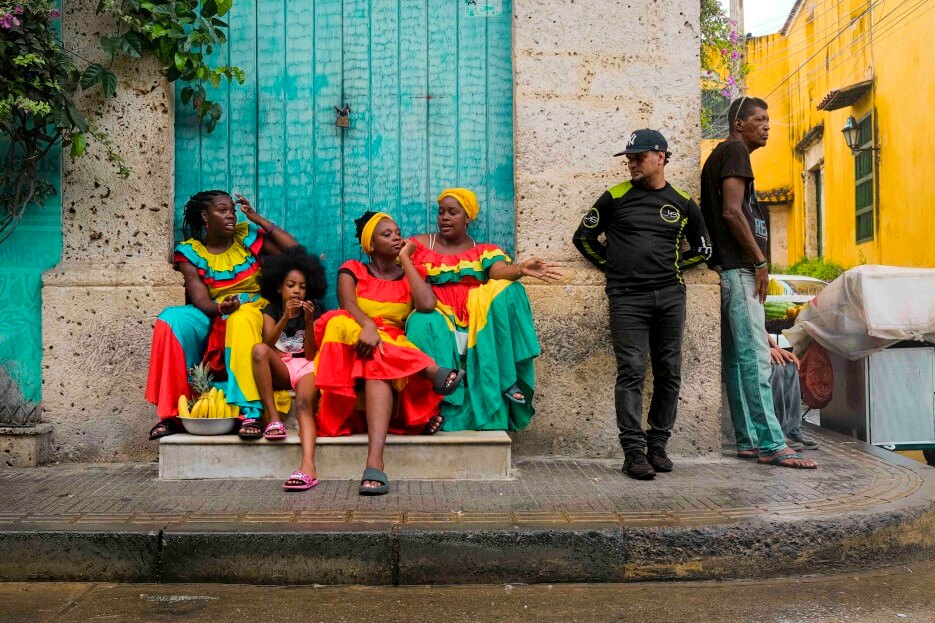
The reason my daughter and I went to Colombia for our birthday adventure trip was at the recommendation of our colleagues and friends from Opportunity Travel, Barb and Michelle Sedita. Erica was coming from Los Angeles, I was coming from Paris and we wanted to end up in New Orleans for my brother-in-law’s 90th birthday party and family reunion. It made sense for us to meet somewhere in the middle, but I never would have dreamed of making Colombia a destination to celebrate my own birthday. However, Barb and Michelle knew a whole lot more than we did about the possibilities and were able to orchestrate the excursion from beginning to end without a hitch. It was brilliant, to say the least.
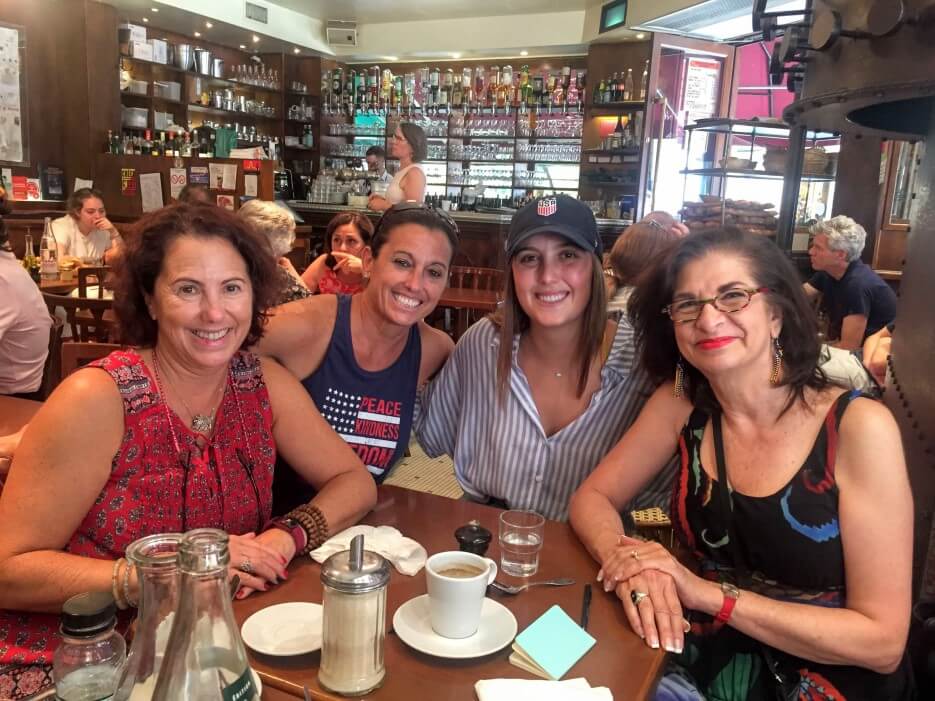
Adrian with Barb and Michelle Sedita and Barb’s daughter, Jamie Perriello
In 2011, Colombia had the fifth worst reputation in the world for crime, according to the Country RepTrak poll, when 37.08 out of 100 citizens of the United States, United Kingdom, France, Italy, Germany, Canada, Russia, and Japan declared it so. More recently, International Living gave it a more balanced report on why or why not it was a great place to live. CNN Traveler recently professed “How Colombia, Once Consumed by Violence, Became Your Next Destination.” We were game to give it a go after hearing the rave reviews from Barb and Michelle.
Opportunity Travel arranged every inch of our one week in the South American country, starting off with a few days in Cartagena, then moving on to the “Coffee Triangle” (or “Coffee Axis”) before heading north to New Orleans. We didn’t have to lift a finger or think about anything…just sit back and enjoy the ride. It wasn’t as expensive as you might think, because the U.S. dollar is worth about 4,700 pesos at the time of this writing (just take off three digits to get a more reasonable sense of the currency exchange—4.7) which buys you a lot. The average cost of a double hotel room is $18.70 and a breakfast out is just $2. The bottom line is that we could have a luxury vacation for very little money by U.S. dollar or Euro standards.
We flew to Cartagena from Miami on American Airlines. That was a piece of cake, but then stood in line to get through passport control for about one-hour-forty-five minutes, which would be torturous for most, but nothing was going to get in the way of our good time. It reminded us of the worst experiences we’d had in passport control in the past, which for me were in Delhi, India and during the Covid-19 pandemic, in Los Angeles with almost as long a wait, everyone masked (or many not adhering to the rules). Our tour guide, Cesar, waited all that time outside for us to emerge from the airport, and then off we went.

We had chosen one of the best hotels in the colonial era city, the Casa San Agustin, in the very heart of the old town within the ancient walls. It consists of three beautiful white-washed houses, only 20 guestrooms and 11 suites, decorated in authentic Colombian style, but with seamlessly modern services. In all honesty, I’d never experienced such luxury in my life. And while my daughter has had the good fortune of traveling with some of the richest people on the planet, she too was as impressed as I was. The service was impeccable.


Once we settled into the beautiful room, Cesar took us on a walking tour of the narrow streets filled with both souvenir shops and luxury boutiques before letting go of our hands to wander around as freely as we wanted. We saw a lot we wanted to explore further, but couldn’t wait to try out a local ceviche and Colombian coffee. Meanwhile, we took in the sights and sounds of the colorful buildings, the colorful handicrafts, and the even more colorful people. Everywhere you look is total eye candy, to the point of almost being “Day-Glo.”


By car the next morning on my actual birthday, with Cesar talking virtually non-stop (he was adorable, even if a bit verbose), we visited a few major sights and got to know a lot more about the town that is the fifth largest city in Colombia and one of the most major ports of the Caribbean coast region, that served as a link in the route to West Indies. “As a former Spanish colony, it was a key port for the export of Peruvian silver to Spain and for the import of enslaved Africans under the Asiento slave system”—the African slave selling license issued by the Portuguese and Spanish crown allowed merchants the monopoly on a trade route for merchandise. (Source: Wikipedia.org) The city was founded on June 1st, 1533, so there’s a lot of history under its belt to learn and discover.
We began early by driving to the top of the hill to visit the convent, cloister and chapel of Nuestra Señora de la Candelaria de la Popa on the top of Mount la Popa, also called Convento de Santa Cruz de la Popa. The views of the city from this perspective are impressive and one cannot be awed by the juxtaposition of the shanty town structures on one side of the city compared to the luxury modern high rises against the sky on the other. The tallest building in Cartagena, the Hotel Estelar Bocagrande, stands 202 meters (663 feet).

In the heat and humidity, we opted out of climbing to the top of the Castillo San Felipe de Barajas (San Felipe de Barajas Castle), a fortress in the city built in 1536 on the Hill of San Lázaro in a strategic location, dominating approaches to the city by land or sea, but stood at the bottom to admire its presence. It was originally known as the Castillo de San Lázaro and built by African slave labor under Spanish supervision during the colonial era. The fortress was involved in several battles between the late 17th to early 19th centuries between European powers.
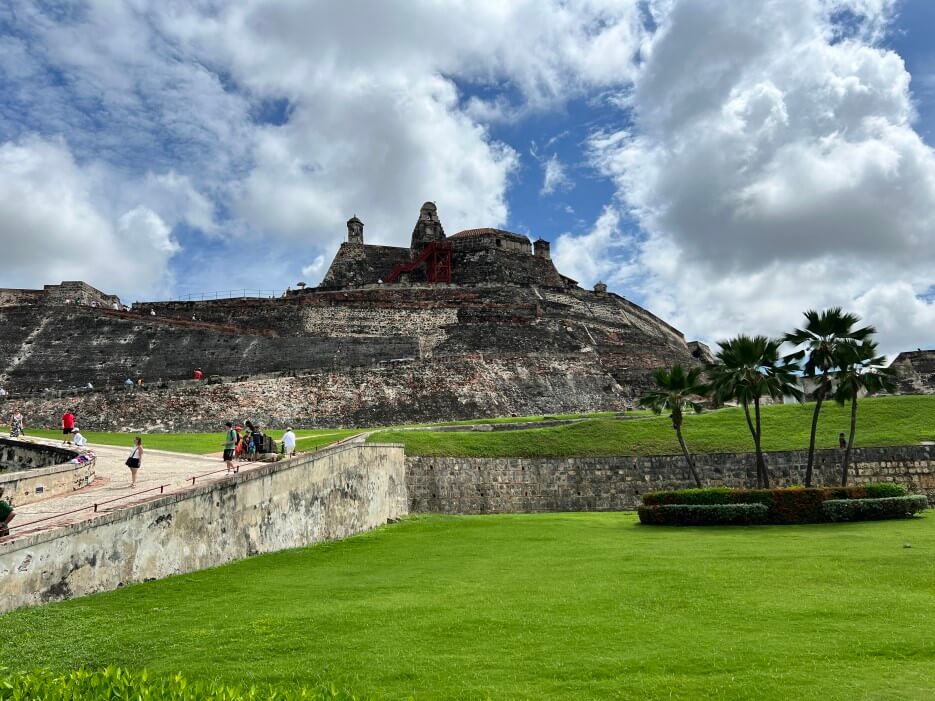
Once we’d had our fill of history and getting to know a bit of the lay of the land, after a lunch of typical Colombian fare at “Il Vitrola,” Erica and I went off on our own shopping spree, bargaining as best we could when needed, and otherwise, enjoying more of the luxury shops that had taken local handicrafts to new heights. With everything so inexpensive, we could afford to indulge ourselves. What abounds are handwoven bags, emerald and gold jewelry, and espadrille shoes. The tiniest of bikinis are everywhere you look as are beach cover-ups and loose-fitting colorful print silky clothing. As it is in any place touting their local crafts, after a short time, everything starts to look alike and nothing seems very appealing. At least, that’s how it is for me. So after a while, I gave up trying to find reasonable souvenirs.

Colorful interior of the restaurant Il Vitrola
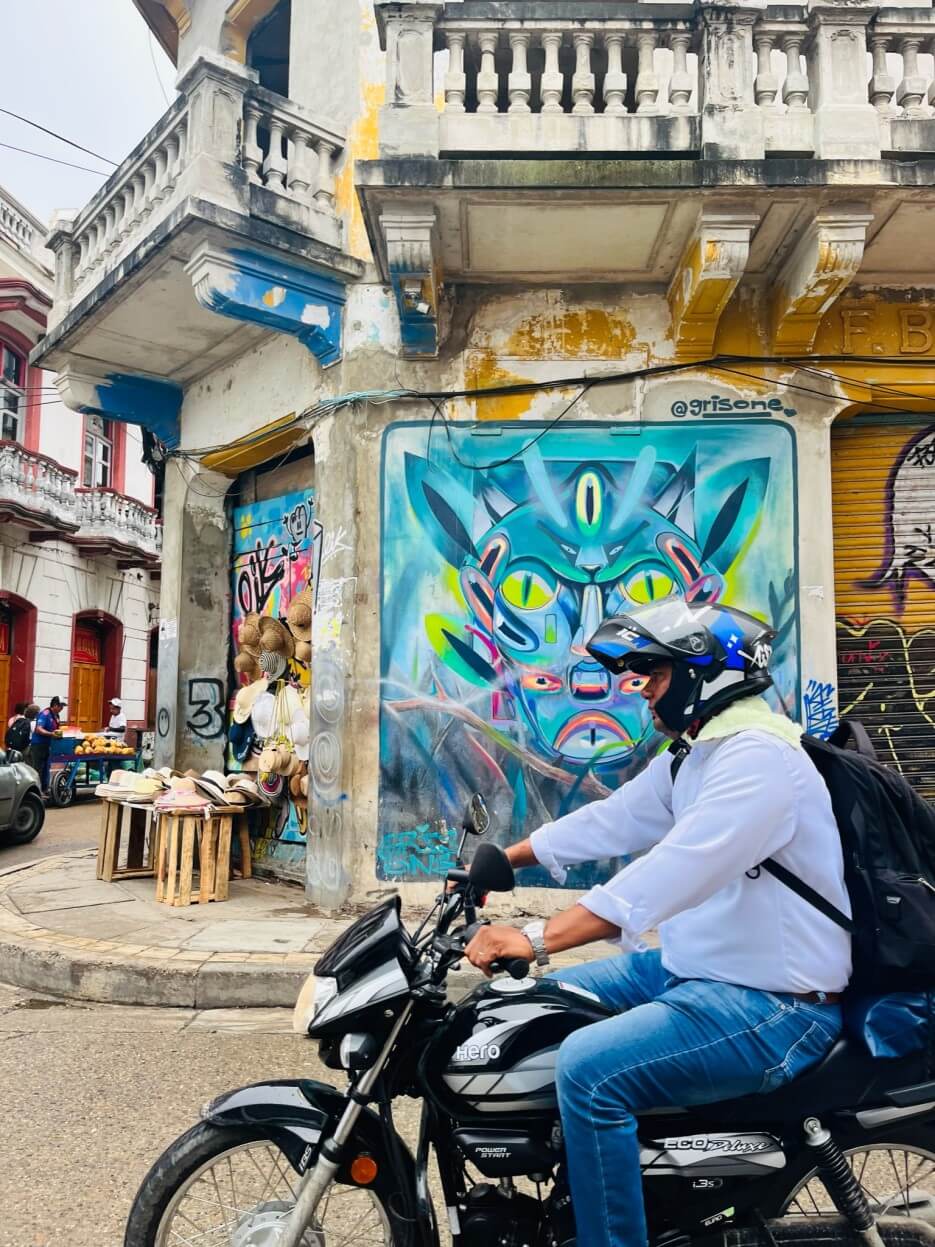

Culinary arts abound—a taste and style that is comprised of six main regions: Pacific, Amazonian, Andean, Orinoco, Caribbean, and Insular, but particularly influenced by Indigenous Colombian, Spanish, and African cuisines. That’s a mouthful just describing it, but what’s left are lots of ceviches, sweet coconut rice, plantains in many forms and seafood of every kind. We ate in some of the best restaurants, including the hotel restaurant, “Alma,” for my birthday dinner. Highly rated on most websites, it was a beautiful, elegant and excellent experience, even at breakfast. But we had to admit that the local cuisine didn’t sit well with our own very “clean” diets that eliminate fried foods, sugar, starches, etc. Fresh vegetables are simply not on the menus and even the salads aren’t up to our par. We hadn’t come to Colombia for the food, so this wasn’t so important to us, but Erica and I both agreed that Portugal has beaten everywhere else we’d ever been for food of quality, taste, creativity and health.

Ceviche on the beach

A sumptuous dinner at Restaurant Alma
The hotel staff and service was impeccable. On the afternoon of my birthday, a group of about four knocked at our door holding a big bouquet of balloons and a special chocolate dessert, singing “Happy Birthday” as I opened it. I’m not sure who orchestrated that—if it were the Opportunity Travel ladies or if the hotel thought of it all on their own, but it was quite a touching surprise.

On our third day in the city, we took a 50-minute boat trip to the Gente de Mar resort on one of the 28 islands of Rosario about 40 kilometers southwest of Cartagena. This is the rainy season in Colombia, so we were taking our chances for such an excursion. As we waited for the boat at the port very early in the morning, a torrential rainstorm came down, lightning and thunder, soaking everyone and everything and rendering the boat about 30 minutes late from embarking. Once the clouds lifted, however, the sun broke through and our day on the island turned out to be better than perfect.

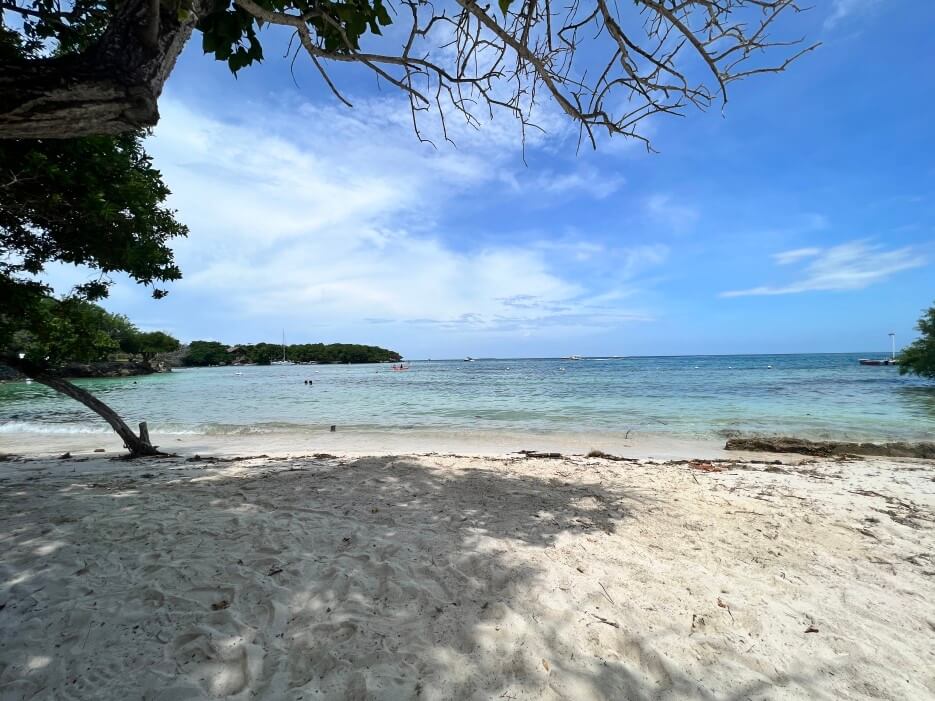
The islands are lush and gorgeous—a tropical paradise. For six hours, we hung out on chaise lounges on a sandy beach under the shade of a tree, had lunch of fried fish and plantains and enjoyed swimming in the very warm water of the Caribbean. Fishermen were hawking their fresh catches, including one guy with a bucket of oysters who offered them up with lime and hot sauce for a price. He shucked them in front of us as we downed a dozen of the small, but sweet succulent mollusks. It was my favorite culinary delight of the entire trip to Colombia.


We had booked a two-hour body scrub and massage at the hotel spa upon our return from the islands which was entirely self-indulgent and the best spa treatment of our lives…at least of mine. The spa itself was totally luxurious. We were so relaxed from the expert hands of the two masseuses that after the full treatment, we stayed in, ordered room service and watched TV in the calm of our beautiful room. The day had been exemplary, in spite of the heavy rains at the onset.
Showers came down daily at one point or another, but the temperatures were so warm that it didn’t really matter how wet we got. And when you go, be prepared for humidity as high as 95 percent…it’s downright steamy. The rule of thumb is never to leave home without an umbrella if you visit Cartagena at this time of year. (For a good overall weather report, visit this site)

Sunday was a free day with no special plans, so Erica and I decided to walk to another part of the city—the Barrio Getsemani, considered to be the coolest, hippest part of the city. You know it the minute you cross over a main road from the old town to reach this neighborhood that is bumper-to-bumper with bars, restaurants, and some of the most colorful houses and artistic murals one might ever encounter. The tourists here are more local Colombians than foreigners like us. This is where you will find poets, painters, photographers, and other artistic types. No matter where you wander, as we did, up and down the streets decorated by flags and umbrellas, all streets seem to lead to Plaza de la Santísima Trinidad (Plaza Trinidad), which is anchored by a church built in the 17th century. Naturally, it poured down rain as we were wandering through the area, which rendered us soaking wet, but free of too many tourists. We found respite in a tiny café selling a few local handicrafts.


Once the skies cleared, the throngs of visitors came out and we landed in a very local, but large restaurant known for it’s typical Cartagenian culinary delights and tasted an assortment of seafood in garlic sauce.

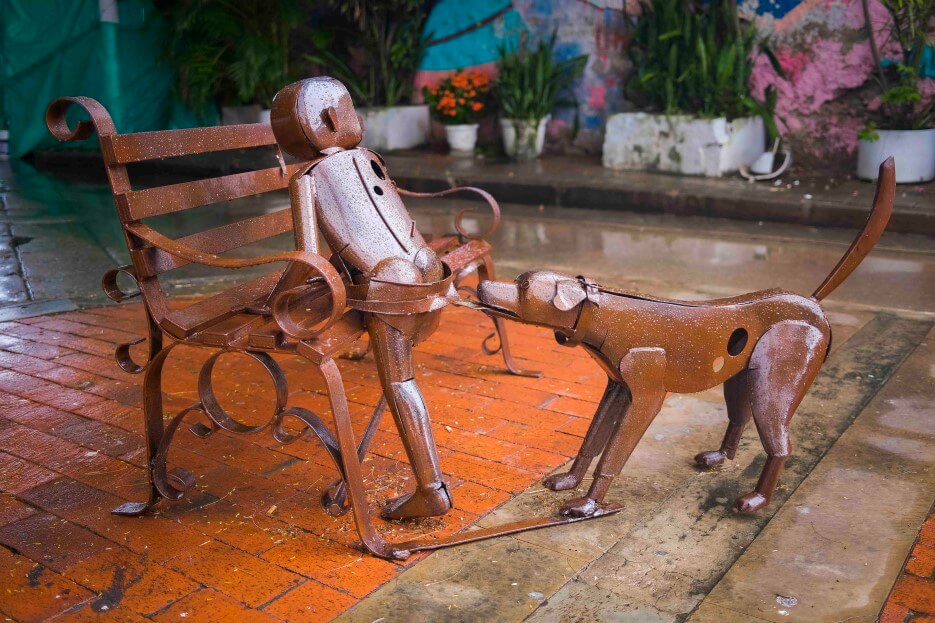
 Before heading back to the hotel for the evening, Erica and I wandered over to La Serrezuela, an icon and historical landmark of the city of the 20th century that is now an elegant shopping mall. I resisted going in, as I seriously detest such commercial centers, but this one is worth a special detour. Once a bullring dating back to 1893, the round iron structure has been completely refurbished and reborn as both a shopping mall and a cultural space.
Before heading back to the hotel for the evening, Erica and I wandered over to La Serrezuela, an icon and historical landmark of the city of the 20th century that is now an elegant shopping mall. I resisted going in, as I seriously detest such commercial centers, but this one is worth a special detour. Once a bullring dating back to 1893, the round iron structure has been completely refurbished and reborn as both a shopping mall and a cultural space.

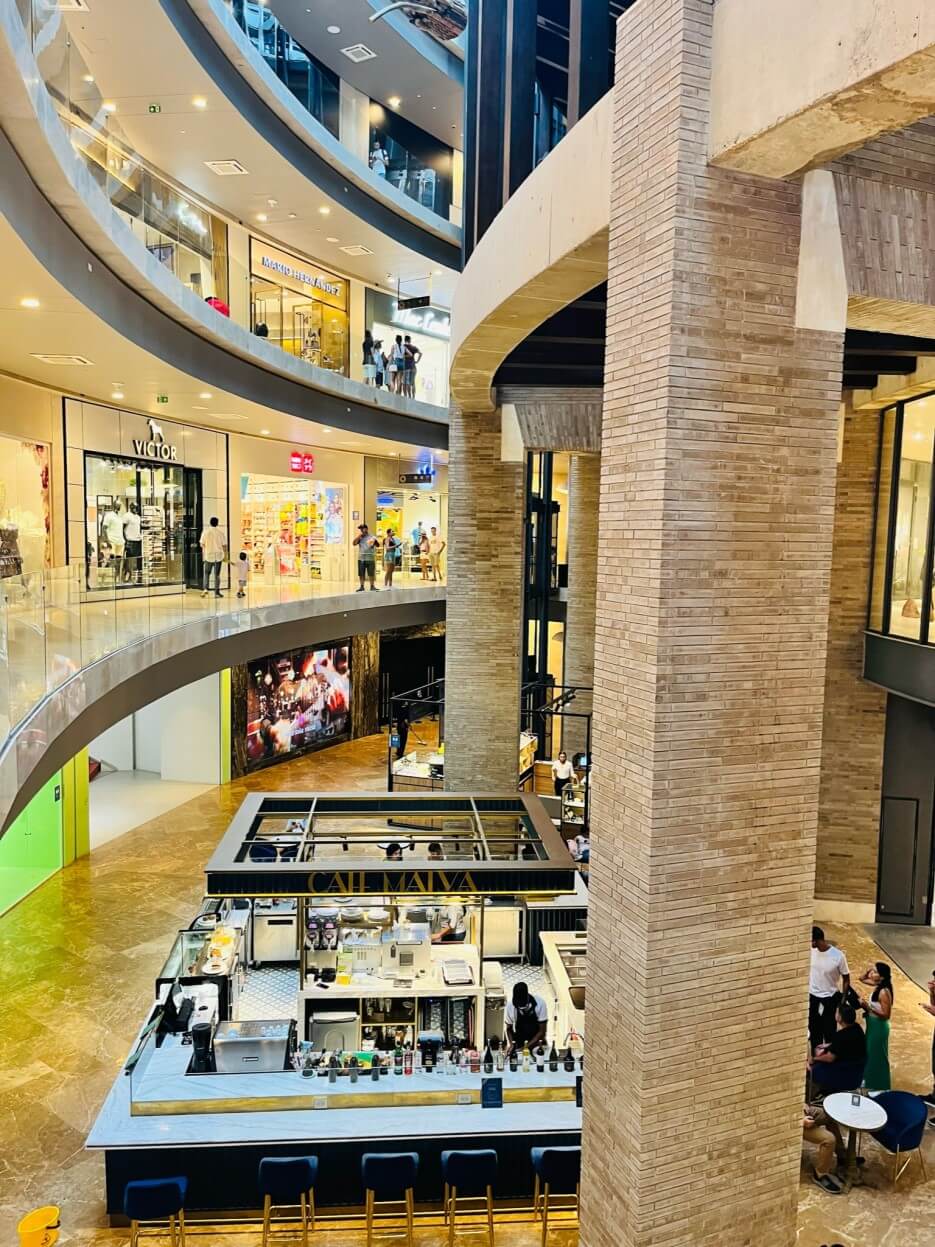
When you get away from the more commercial part of the old town, to the streets that are more residential on the outer edges, there are beautiful homes that one can only surmise must be Cartagena’s most expensive real estate. In 2013, Justin Bieber bought a $2 million 3,250 square foot mansion in the Colombian town and Mick Jagger, who’s been visiting Cartagena for years, is said to have a property in the city too. The city’s biggest claim to fame, however, may be novelist Gabriel García Márquez, Colombia’s Nobel laureate writer, who kept a house in the historic center until he died in 2014. I found likenesses of him on souvenir pouches. One can almost feel his presence.
Coffee is what may be for which Colombia is most well known, besides drugs! For that reason, we flew from Cartagena to Pereira Monday morning for a few-day adventure in the coffee region (or “Eje Cafetero” in Spanish), also known as the Coffee Triangle. This is a part of the Paisa region in the rural area of Colombia famous for growing and producing the majority of Colombian coffee. There are four departments in the area: Caldas, Quindío, Risaralda and the north municipalities of Tolima and Valle del Cauca. The most visited cities are Manizales, Armenia, Pereira, and Ibagué.
Our stay there was booked in a boutique hotel on the outskirts of Pereira—the Sazagua Hotel—recalling the old mansions of the coffee producers with a wooden structure, wide corridors and lively colors. As we drove from the airport, we got deeper and deeper into the lush green landscape, then were overwhelmed by the beauty of the setting on which the hotel was situated, the Risaralda Department. Within moments, we were at a table on the patio having a gourmet lunch watching a swarm of tiny yellow birds feeding on and around a nearby tree.


 Our room was on the ground level directly off the lobby with a private garden on which was a table shaded by a parasol, with a hammock and completely surrounded by plants. We had thought to go out to a nearby hotel for dinner in one of the area’s best restaurants and view of the landscape, but the rain came down in such torrents that we hunkered down, worked on our computers, drank Columbian coffee and had dinner on the patio of our lovely hotel.
Our room was on the ground level directly off the lobby with a private garden on which was a table shaded by a parasol, with a hammock and completely surrounded by plants. We had thought to go out to a nearby hotel for dinner in one of the area’s best restaurants and view of the landscape, but the rain came down in such torrents that we hunkered down, worked on our computers, drank Columbian coffee and had dinner on the patio of our lovely hotel.
Tuesday morning our guide and driver picked us up early to take a two-hour drive to Buenavista, the department’s smallest town. Sitting high above the enclave is one of the country’s finest and award-winning coffee plantations…San Alberto. The drive took us through the lushest greenery I’d ever seen—a carpet of green on rolling hills, punctuated by coffee plants, groves of avocado trees, plantain trees and tons of bamboo. It boasts of the second-highest woody bamboo diversity in Latin America.

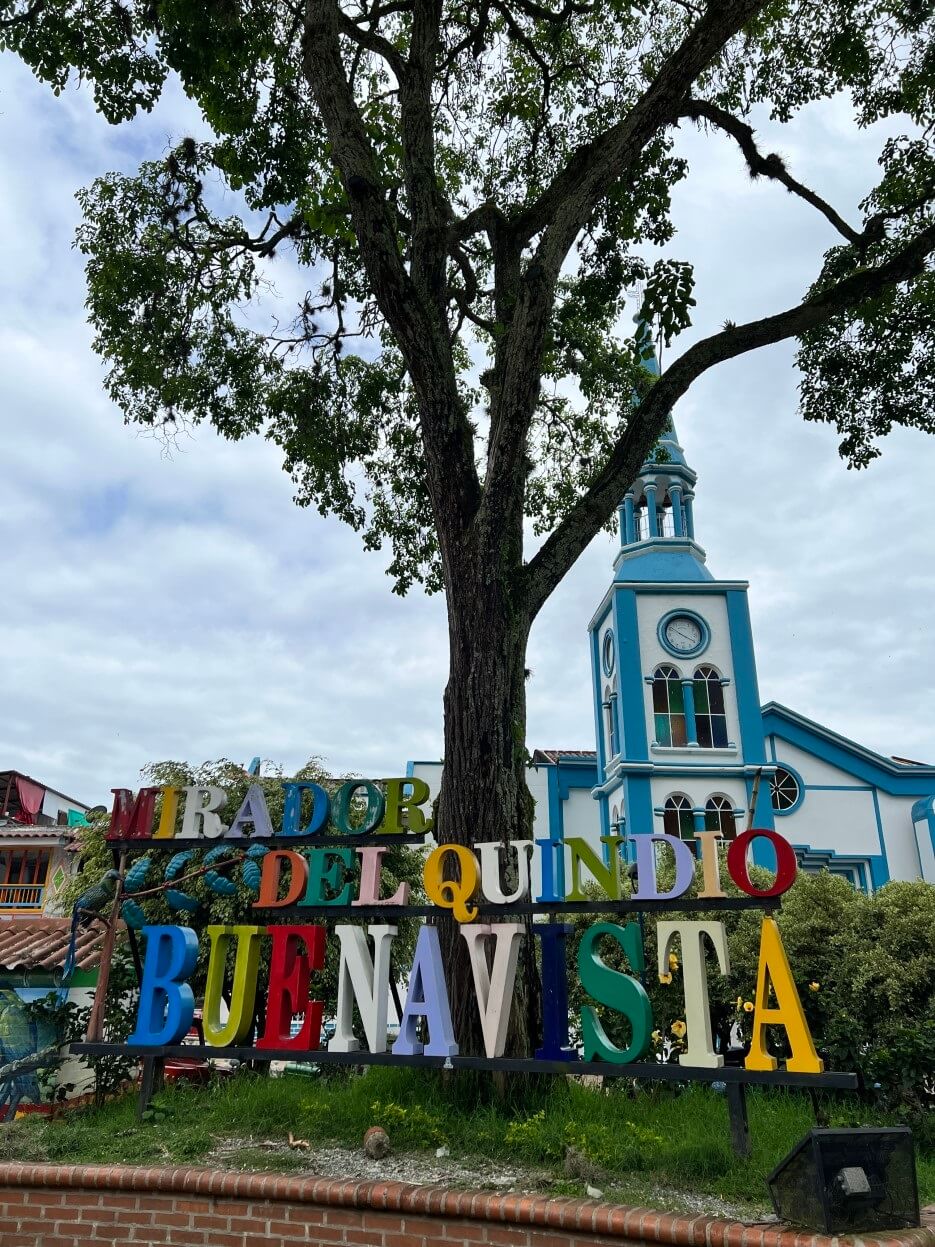
Buenavista, in the department of Quindío, is known and named for the spectacular view over the department with an estimated population of 5,800, of which 2,100 live in the urban center. The views from the town, and in particular from the San Alberto coffee farm much higher than the town, are breathtakingly beautiful.
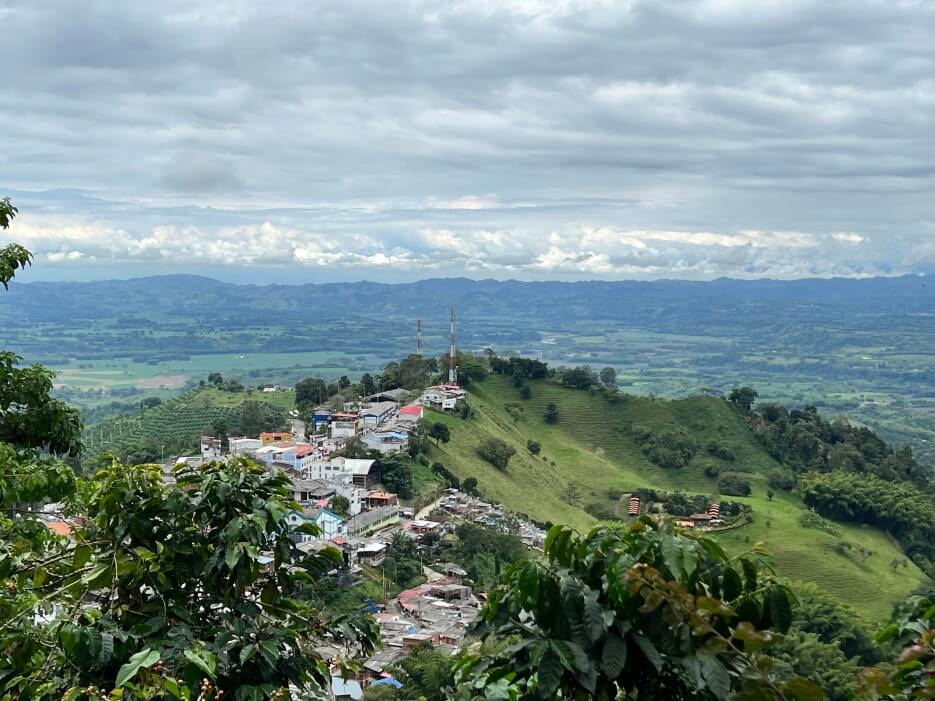
We didn’t realize until well into the tour of the farm and coffee-tasting experience that we had tasted the coffee in their café and boutique in Cartagena days before without realizing we were scheduled to visit the source. And what was even more surprising to us was how we weren’t fond of the taste at the time!

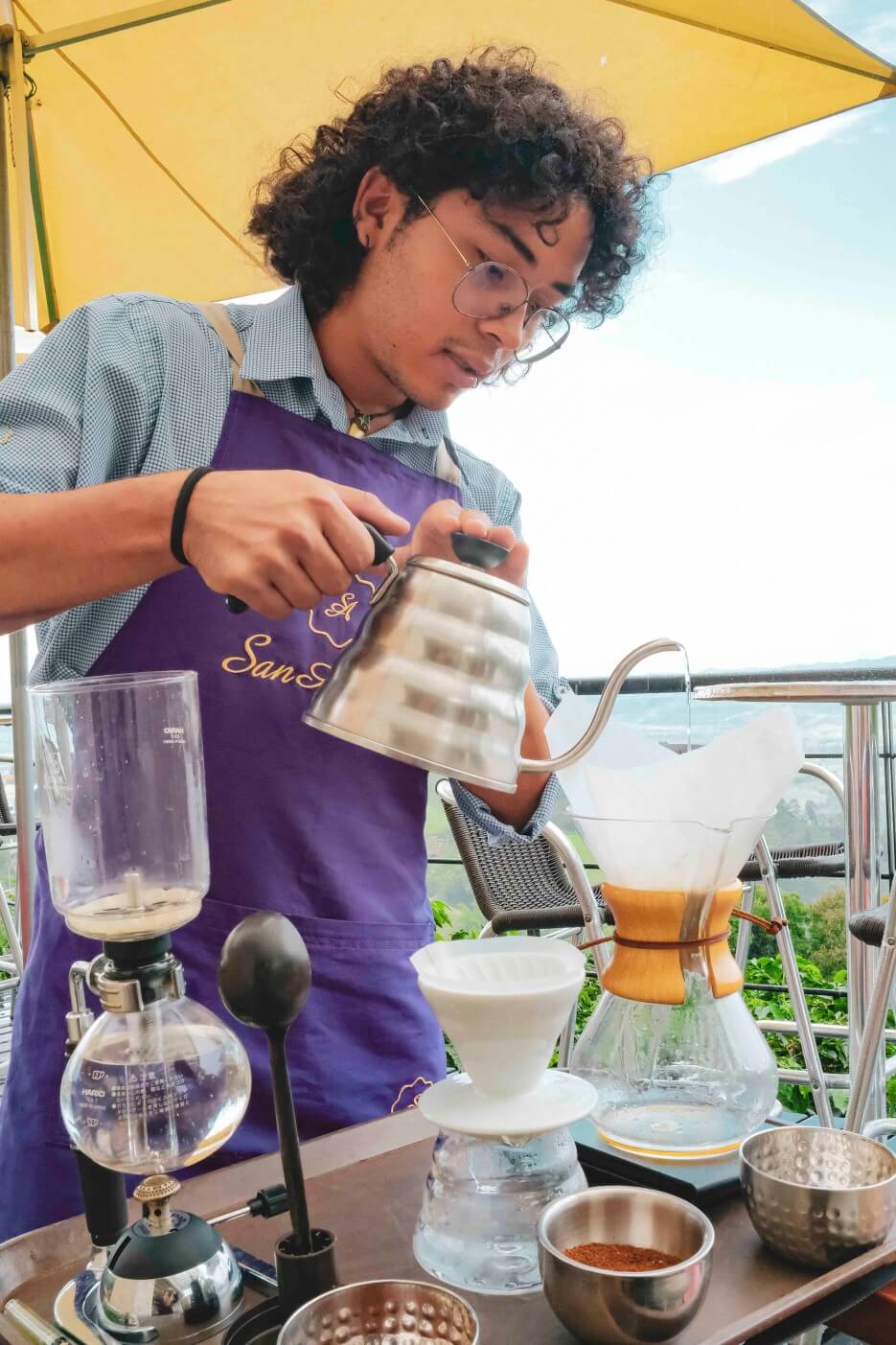
Their guide, Juan Pablo, took us on a personal tour into the fields of coffee plants and described every facet of growing and processing the coffee beans to achieve particular blends, flavors and aromas. We went through a coffee-tasting ritual to more fully understand what’s behind the coffee that is described as having “pleasant aromatic notes, sweet, fruity reminiscent of caramel and a smooth dark chocolate, with a remarkable acidity, fruitiness, creamy body and harmonious balance.”


Family-owned, its history dates to 1972 when Gustavo Leyva, the founder, when he purchased the property and called it San Alberto in honor of his son Gustavo Alberto who died tragically in a plane crash. In 2011, San Alberto received its first Gold Medal at the World’s Fair of Food in Moscow, then it was the first Colombian coffee to receive the highest distinction in the prestigious International Institute of Taste and Quality (ITQI) with three Golden Stars. These were just the first of many awards to come.
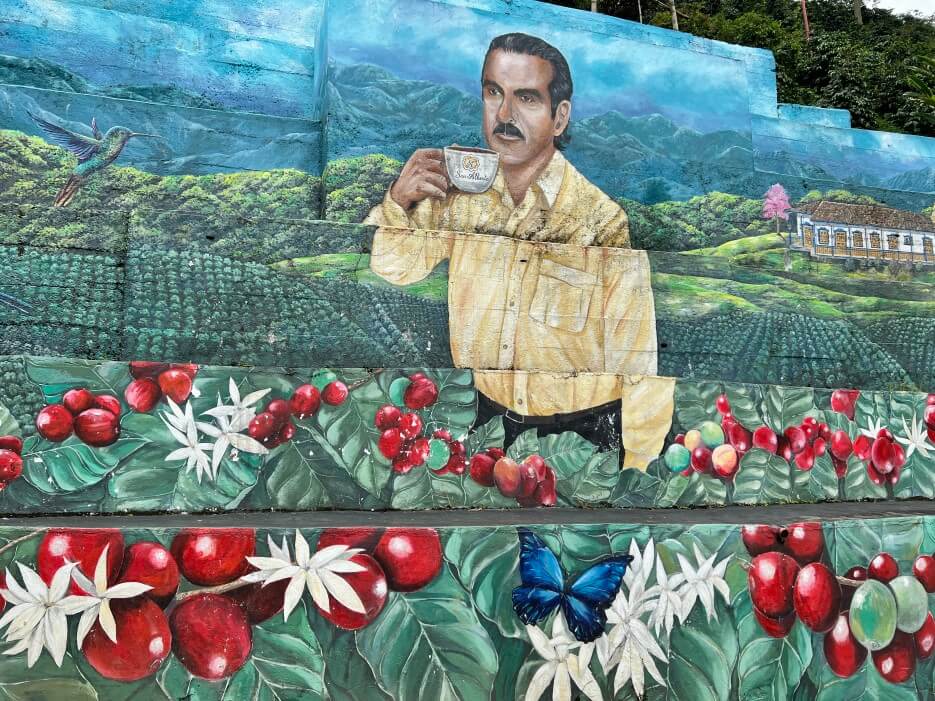
Our last day in Colombia was one of our finest, in spite of the fog and rain. As we drove to the Cocora Valley, home to the tallest palm trees in the world, the Wax Palm, we feared we’d never get to see them due to the inclement weather, but miraculously we lucked out. Somehow, just after lunch in one of the area’s most well-known restaurants to have one of the local specialties (fresh grilled trout), as we drove toward the valley, the fog lifted, the skies turned blue and the rain stopped long enough for us to hike through the area for almost two hours. We felt blessed.



It’s part of the Los Nevados National Natural Park, incorporated into the existing national park by the Colombian government in 1985. It’s a very popular destination, even for Colombians, not only to see the palms, but also for bird watchers, mountain bikers, horseback riders, and those enjoying water sports such as rafting and swimming in the rivers. It was obvious why—the palms and the vistas are breathtaking…even with the fog obscuring the views, creating an almost eerie atmosphere.
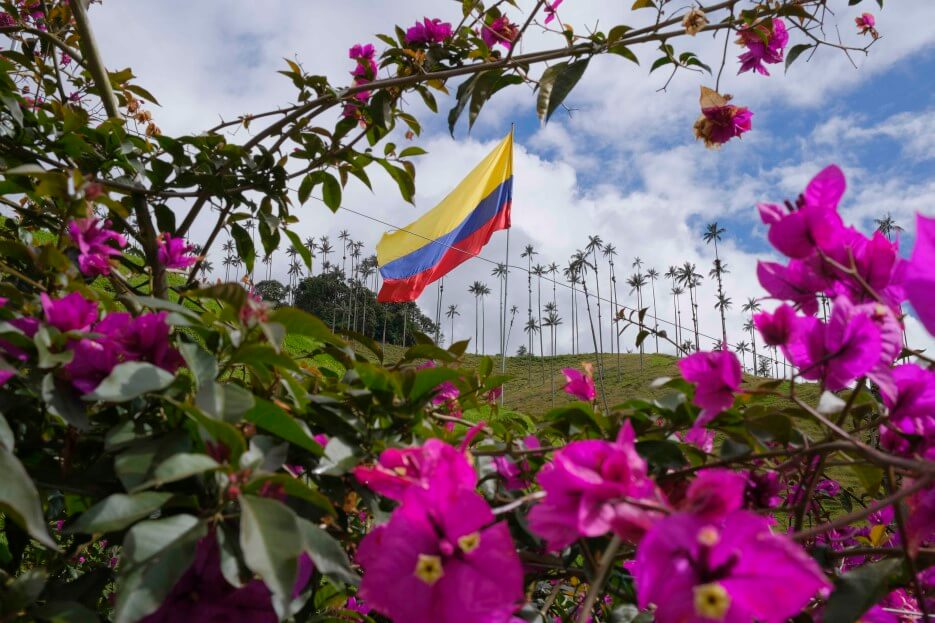
During this one long day, we visited both the towns of Filandia and Solenta and saw vistas from their various viewpoints. Filandia is part of the coffee-growing axis and the historic center of the town was made part of the “Coffee Cultural Landscape” UNESCO World Heritage Site in 2011. From here we had extensive views over the Cauca River valley to the west and the Parque Nacional Natural Los Nevados to the east. The town square is typical of most Colombian city centers: a park in the center, square-shaped, beautifully planted with benches on which sit the elderly residents, surrounded by what every town needs: a church, city hall, police station, pharmacy, bakery, market, cafés, restaurants, etc. Salento is known for its coffee estates and verdant scenery and is a gateway to the snow-capped peaks of the park. In Salento, Calle Real, the main street, has colorful buildings and craft shops, as did the main street of Filandia.

Finlandia town square

View of Solenta from a distance

In these two towns, we found lots of artisan-crafted souvenirs, even more interesting than we had found in Cartagena. We were the only Americans around, unlike Cartagena, where foreigners of all kinds abounded. One big surprise, while shopping around in Solenta and stopping for a coffee, we came upon a kosher restaurant with Israeli flags hanging and large Mogen David stars, with signs written in Hebrew.
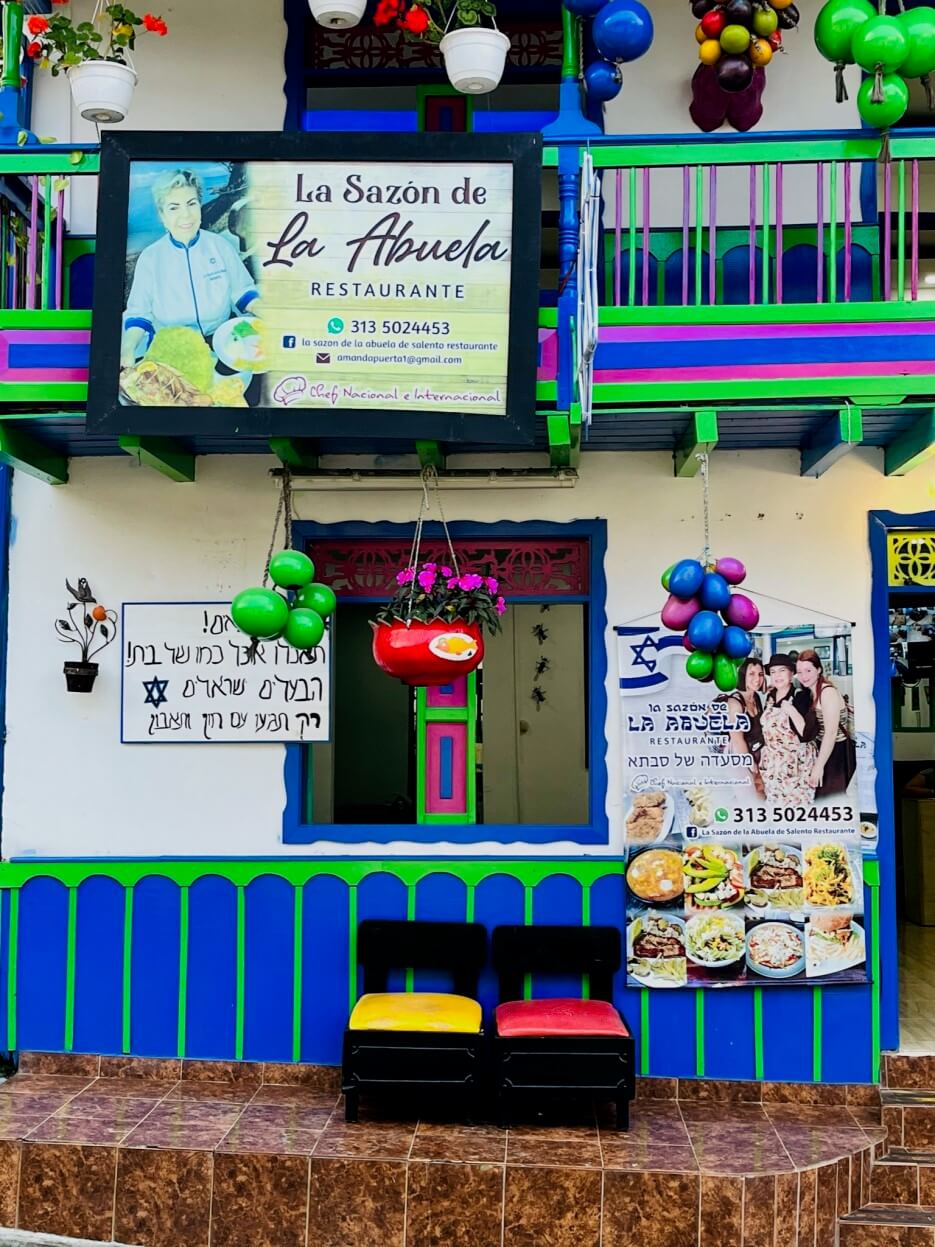
What I later learned is that there are actually about 8,000 practicing Jews who live in Colombia. Most of them are concentrated in Bogotá, with about 3,500 members, and Cali with about 1,000 members. New communities can also be found in Barranquilla and Medellín. They have quite an interesting history in the South American country, as they do in most, but this certainly wasn’t what I expected!
Thursday we took the entire day to arrive very late at night in New Orleans…but I will leave notes about “NOLA” for another time, so stay tuned.
Special notes on traveling to Colombia:
It rained every single day and in many instances, serious downpours that might have made a mess of such an adventure, but we were prepared, and lucky to avoid the worst of it. The one big advantage to traveling during the rainy season is that there are fewer tourists this time of year, everything is less crowded and often we felt we had the country all to ourselves!
If you’re looking for gourmet dining, this isn’t the place. Face it, you don’t go to Colombia for the cuisine. Eating healthily is near to impossible as fresh vegetables are simply not on the menus. Even the fresh fruit was surprisingly tasteless and of a much lower quality than one finds in France. Most people might like it more than we did, however…as we don’t eat dairy or sugar and that makes it more difficult.
Colombia might be the most colorful place on the planet…at least from what I’ve seen. The landscape is green, green, green and green—greener and lusher than Ireland could ever imagine. The earth is just a carpet of green, obviously thanks to the rain and warmth. Everything imaginable grows here. Then, the houses are absolute rainbows of color as is just about everything they make and sell. I thought of Gray Paree and couldn’t believe the difference!
A la prochaine…
 Adrian Leeds
Adrian Leeds
The Adrian Leeds Group®
Adrian with daughter, Erica, in Cartagena
P.S. About half of the photos here are at the hands of my photographer daughter, Erica Simone. While I took tons of photos myself, her eye and talent are tough to beat. She has a photojournalist’s eye and sees through her lens moments in time that most can’t capture, particularly me. It takes the pressure off me to record our adventures knowing she’ll do a much better job! Hope you enjoy them.
 P.P.S. I would urge you to contact Opportunity Travel for such excursions—they have the know-how and experience to make it all happen. See their website for more information…and tell Barb and Michelle I sent you.
P.P.S. I would urge you to contact Opportunity Travel for such excursions—they have the know-how and experience to make it all happen. See their website for more information…and tell Barb and Michelle I sent you.
1 Comment
Leave a Comment
To read more, click the links below.


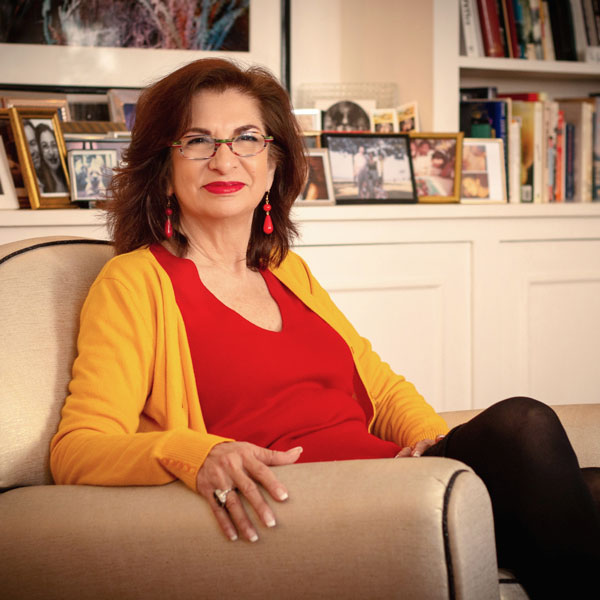






Gosh Adrian, When I was in Colombia, you couldn’t beat the fresh vegetables and fruit and what I thought were the tastiest eggs and chicken on the planet!? Oh well a different experience but it all looks like a wonderful trip!